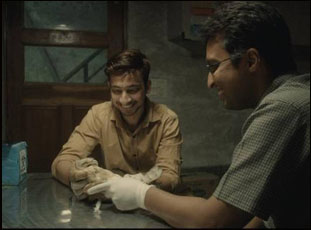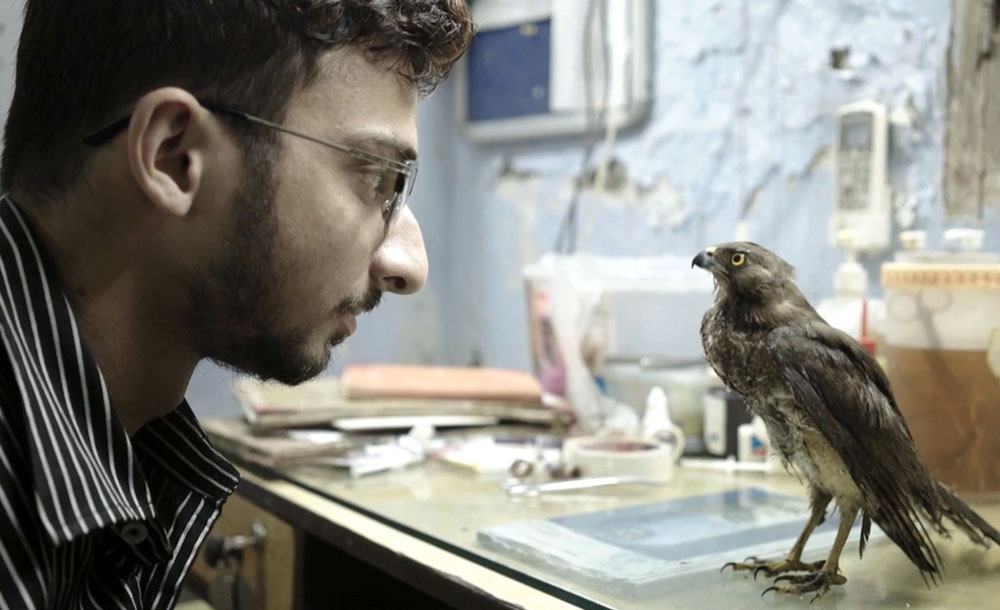Where others may see walls, Shaunak Sen saw an opening when he started on the path to make what would become “All That Breathes,” heading into the basement of Nadeem Shehzad and Muhammad Saud, two brothers who have turned their family home in Delhi into a rescue facility for the birds. If he was going to make a film about the increasingly fraught ecosystem that was causing the black kites to fall from the sky at an alarming rate, there was no more appropriate place to start than the subterranean bunker where the birds are tended to with intricate care but the camera will often stray to the other creatures that live beside them, from the rats crawling along the pipes to the snails that slink by on the streets outside, having the entire world up even before the brothers and their co-worker Salik can send out their repaired patients from the rooftop.
“I firmly believe that in order to be universal, you need to be very particular and specific,” says Sen. “Within each of us as individuals, we contain within ourselves the whole span of human emotions, like the most epic Apollonian virtues and the darkest kind of things, so you just really need to zoom in to zoom out.”
If “All That Breathes” manages to convey the full array of experiences in Delhi without leaving the cloistered lives of the veterinarians, which in its broad strokes is no different than most anywhere else in the world these days when political strife and environmental catastrophe have converged to make every day feel like walking through a fog, it is only natural that Sen has transcended the edges of the screen itself to deliver one of the most transfixing experiences you could have in a darkened room. Curiosity knows no bounds in the film with the camera often leaving one area to follow its interest into another slow, steady pans, be it outside where there are no shortage of natural wonders from the swirl of birds in the sky to the monkeys parading across power lines or inside where the brothers have resourcefully rejiggered their domestic space for a rehab clinic, with their medical practice living side by side with the ephemera that has piled up while they’ve pursued it.
Although the situation can seem dire when the clinic can only nurse so many birds back to health and the brothers run up against the bureaucratic deadlock of grant applications that could help with their operations yet take time and energy away from their work, the film manages to remain pragmatic as it inspires, not only allowing for the world to be seen from an entirely different perspective but one that admires the spirit of those who continue to carry on in the face of grave existential threats. Following its unprecedented festival run where it picked up top prizes at Sundance and Cannes, “All That Breathes” is beginning its American theatrical run and Sen graciously took the time to talk about placing audiences in the same spaces he once stood himself to capture the feeling of having the ground slowly erode beneath your feet and the hope that still resides above.

I think it began as a kind of loose texture, like an abstraction and for everyone who lives in Delhi, the pervasive grayness is a palpable, concrete thing. You’re always thinking and talking about the air and the quality. The grayness of the monochromatic sky is inescapable, so I wanted to do something that was a triangulation of birds/humans/air and at some point while researching this, I was gripped with the figure of a bird that’s falling out of the great expanse of the sky. I thought where do birds that fall out of the sky go to in Delhi? That’s when I came across the brothers and when I got to that that derelict, decaying and incredibly cinematic industrial basement, before you know it, you have taken your jump off the cliff and it’s a free fall. You’ve waddled into a nonfiction feature, so it’s not anything like I’m going to start working on a film. You’re just falling blind.
The scenes of wildlife in Delhi would seem to take a great deal of patience – did you have the intuition to be there or set out with hours and days at a time to capture what you needed to get?
Intuition is not just a spontaneous momentary thing, but something that’s inculcated over time and it’s part of [embedding there] over three years, and when you’re in the film, you’re drowned in this haze of a fever dream-like trance. You’re dancing to the tunes of the film and the film illuminates your world and your own personal life becomes raw material for the film, so all of us are constantly mindful of where do we get to see enough rats, turtles, snails and so on. We were perpetually seeing the city through the lens of the film and over time you develop an intuitive rhythm of where to see what and the necessary requisites of patience required, so we developed a temperament that was consummate to the film. It feels like a fugue state. Now I’ve moved out, I don’t notice birds are readily as I did those two years, so I feel more back to my regular self, but during those three years we were fully embedded and interpolated into the world.
Some of the scenes I was most moved by in the film was how water was depicted, particularly reflecting back on the city. Was that a motif that came fairly naturally?
Every element of the film [was connected to] the sky and the air and because the air is a kind of vaporous transferring medium, you can either show air through its contaminants or its greyness or you can show air or nothingness through its reflection of nothingness. For instance, there’s a shot where [the brothers are] talking about their childhood and you see a reflection of the building and the ripples in the water reveal to you that it’s a water body, so it’s a reflection of water having both a connection with atmosphere and environment and mood, but also it had a metaphorical import that connects it to memories and the nebulousness of heart. This is why I think all my favorite films really use water — there’s a lot of scenes in Tarkovsky where there’s rain or dripping water — and I’m also profoundly interested in it as a mood-building device.

It evolved organically. For instance, our cinematographers Ben [Bernhard] and Riju [Das] decided that we had to show animals in these kind of uncut, long takes and those slow, languorous pans, so when we realized because we had to give a sense of the life of the animal with the backdrop of the city, we decided that we had to start with four minutes uncut of just rats, and that [idea] inculcated through the shoot, but also with the edit and we decided that a lot of structuring principles would be about compression and decompression. We go from a very compressed space in the basement, which is a very claustrophobic and stagnant to the extremely wild expanses of the skies of Dehli, and we keep cutting from the extreme decompression of the vistas of the city to the extreme compression of the basement. Those dictated a certain editorial pattern and logic.
Was there anything that happened that took this in a direction you hadn’t expected?
The tiny fractures in the relationship of the brothers and the political stuff that was brewing in the background, which you sense obliquely in the film, were impossible to anticipate and the film only becomes richer when it’s more dense with things that the film marches towards but won’t fully frontally engage with, so [it was] all of those things that you decide to not fully make it about, but keep as background presences.

There are different strategies that one deploys with sound. The first is when you are inside the basement, the touch of skin and the ruffling of clothes, the sound makes it very intimate, and if you want to make people feel close to characters, you have to make the ruffling of clothes, the touch of skin [tactile], so in the basement, we did that. Outside, we played a lot with ambient sounds and [we had] a phenomenal sound designer and recordist Niladri [Shekhar Roy] and Jacques [Pedersen], the person who did the sound mix in Denmark. The sound was central to the film because when it comes to animals, animals are rendered palpable as much as visuals with sound, so we worked very hard on the Foley and the details of the talons scratching and the feather ruffling and all of that.
What’s it been like seeing this get out into the world?
It feels honestly a bit unreal, [which] I mean in a non-cliched way. I’m a documentary filmmaker making a quite obscure film on a certain set of birds of Delhi, and to show at Sundance and Cannes and bring it home and show it at festivals is already a huge thing, and I feel very privileged, but also more importantly, this takes the film into certain rooms and start conversations that I didn’t expect it to reach. The fact that the lives of the brothers will get communicated and broadcast across the world is really something and actually that’s the closest I can compute. I don’t have a cogent answer I can give yet.
“All That Breathes” is now playing in New York at Film Forum and opens on October 28th in Los Angeles at the Laemmle Royal. It will expand nationally in the coming weeks and a full list of theaters is here.




